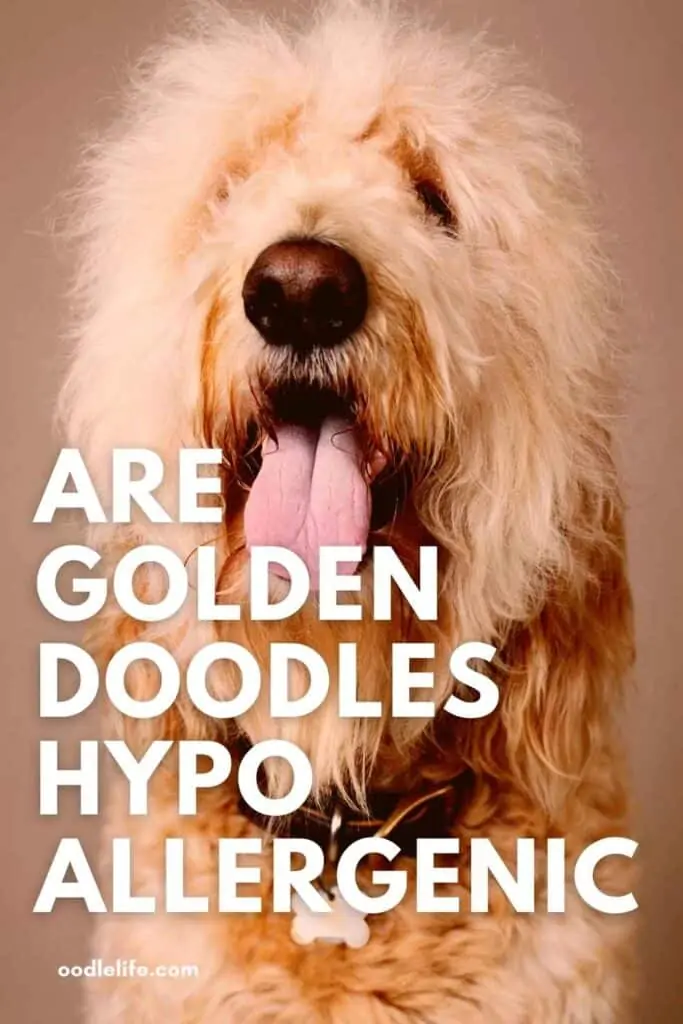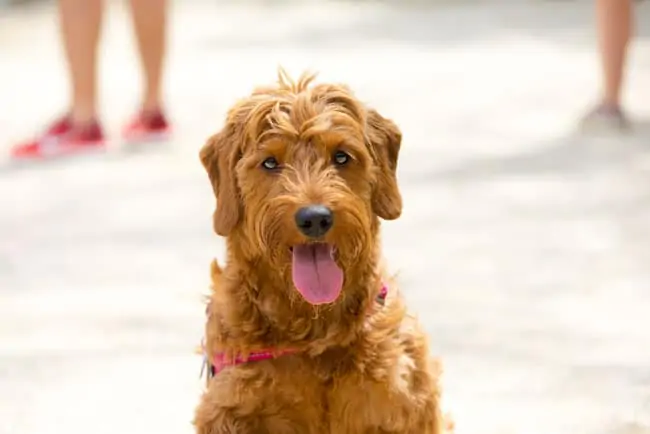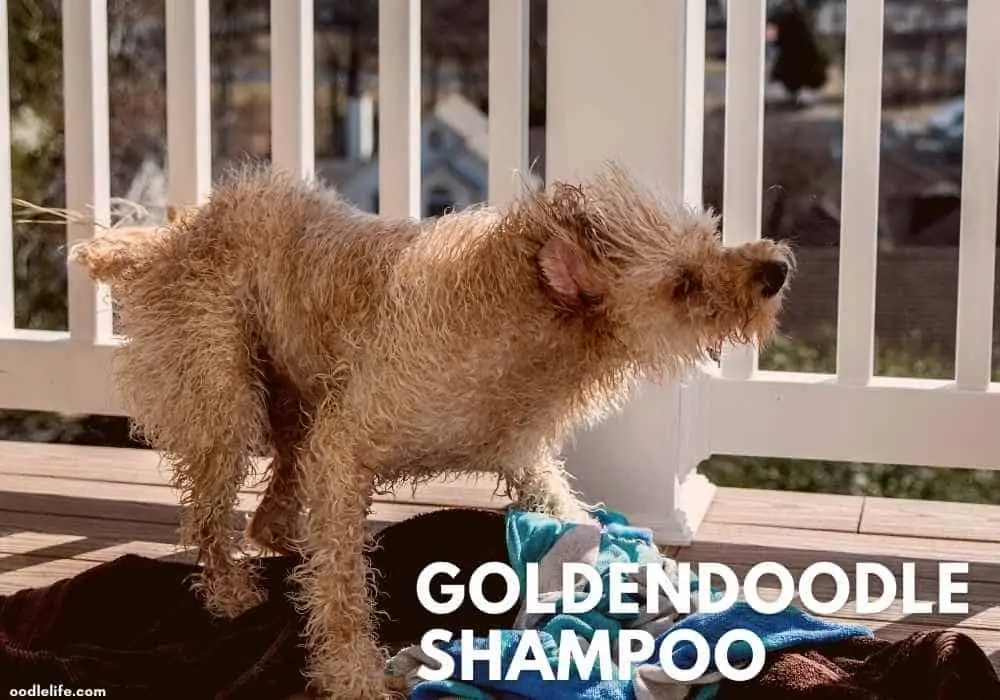Are Goldendoodles Hypoallergenic?
If you believe the hype, Goldendoodles are no shedding, hypoallergenic, teddy bear dogs with very few health problems. But does this ring true? Are Goldendoodle hypoallergenic?

You may have heard that Goldendoodles are low shedding, but what exactly does this mean? Does it mean that they don’t shed at all? Will I still have to brush them? What if I have allergies?
Essentially this just means that they do not shed very much, but because they don’t shed very much, that also means that the grooming routines may be more vigorous.
However, having a low shedding dog will most certainly be better suited for someone struggling with allergies, versus a dog that sheds more often.

One of the funny things about pet allergies is that it’s actually extremely rare to find individuals who are allergic to dog hair or fur, but rather it’s the dander from the skin particles, the saliva, or even urine that can cause allergies.
No matter your situation, we will look to explore the wonderous world of Goldendoodles, and exactly what is required to dealing with any allergens, or sensitivities that may arise from owning one.
Below we will go over what exactly it means to be hypoallergenic, and a whether or not Goldendoodles are in fact, hypoallergenic.
What Does Hypoallergenic Mean?

When it comes down to understanding the meaning behind the word hypoallergenic, it can be most easily understood through breaking the word down into it’s origins.
The Greek word “hypo” quite literally means “under” or “less”, and so is opposite to the word “hyper”. Meanwhile, the word “allergenic” simply means allergic, or sensitive.
For a dog to even be considered hypoallergenic, they must have hair that doesn’t shed, as hair that doesn’t shed does not permit any dander, or dead skin particles into the air (which is what causes allergies).
So, Are Goldendoodle Hypoallergenic?
Technically, no dogs are hypoallergenic, even if a dog is completely hairless it will still produce dander, which can then cause allergies.

The important thing to note here is that while yes, Goldendoodles are low shedding (and about as close to hypoallergenic as you can get), technically speaking, they are not hypoallergenic. Though, while they are not technically labelled hypoallergenic, owning a low-shedding breed will significantly reduce the risk of allergy.
Goldendoodle Coat Type Impact on Hypoallergenic Traits
One important aspect to consider when it comes to the shedding of a Goldendoodle, are the unique coats they can have.

Goldendoodles can have a few different styles of coats, some of which are more likely to shed than others. For example, Goldendoodles that have curly, or wavy coats, are the least likely to shed as they carry the most commonalities with that of a Poodle (who barely shed at all).
Therefore, it is essential that you understand the differences between the coats, and how they each will shed differently.
When it comes to what the options are for Goldendoodles, there are essentially 3 main coat types (straight, wavy, curly), and it will depend entirely on the parental lineage to determine which coat type they will receive.
For example, if a Goldendoodle has more poodle genes, it will likely result in a curlier, less-shedding coat (though this is not always the case).
At the end of the day, mother nature works in mysterious ways, and thus it becomes almost impossible to predict which coat your doodle will have.
However, no matter which type of fur your Goldendoodle receives, it’s paramount that you understand the differences, and what’s required from you to help reduce the risk of allergies.
Straight Coat Goldendoodles
Straight coats tend to look very flat and smooth in texture (similar to a Golden Retriever). They are the least common of the 3 options, however they are actually the easiest coat to maintain, and great for people who don’t have the time to groom their Goldendoodle as much as others.

Straight coat dogs DO shed. They are the least hypoallergenic. The F1 Goldendoodle generation is most likely to have a straight coat.
Wavy Coat Goldendoodles
Wavy coats are the most common of the 3 coats, and is often referred to as the “teddy bear” look. Because the coat is so wavy, it will require regular brushing to keep it matt, and tangle free.

This coat is low shedding, and is as close to being a completely non-shedding coat as possible. The wavy fur type is also one of the easiest to take care of, but will still need to be groomed weekly.
The wavy coat will have more straight hair around their muzzle, whereas Goldendoodles with straight fur, are more likely to have tidy hair around their muzzle.
F1b and F2 Goldendoodle generation dogs will be the most likely to have a wavy adult coat. This coat is usually a non shedding coat. A reputable breeder will often be aware of the genetic markers of their dogs and can predict coat type.
Every Goldendoodle breeder is seeking the waby coat Goldendoodle adult coat. reputable breeder
Curly Coat Goldendoodles
Curly coats are the second most common coat of the 3, and is the one that most closely resembles that of a Poodle. The tightness, and curliness of the fur are the main factors contributing to the resemblance.
And they are actually the most non-shedding coat of the 3, resulting in the most allergenic-free coat of them all.
With that being said, the grooming needs for this coat are quite demanding, as you will need to commit to brushing them every day to prevent matting, or tangling.
A fun feature this coat has is that it actually carries more hair on the top of the muzzle, almost making a curly-styled moustache on the sides of the nose. (This facial hair is known as furnishings and wavy coat Godlendoodle dogs will have it also – it comes from the Poodle genetics).
How to Minimize Goldendoodle Allergens and Dander?

Now that you are aware of the different coats, and how they each shed differently, I’m sure the next question you probably have is “if Goldendoodles aren’t hypoallergenic, then what do I do to help minimize allergens?”.
When it comes to helping to prevent allergies, being that this dog is not hypoallergenic, this means that you will have to put some work in to make sure that it doesn’t become an issue.
With that being said, there are some easy ways you can make a significant impact in creating a better environment for you, and your furry friend!
Grooming a Goldendoodle as a Allergy Reduction Strategy
One excellent way to help minimize the risk of allergies is to take your pet to a professional groomer every 8-12 weeks so that they can deal with the mess of having to bath, trim, and brush the dog.
Obviously, this option is not available for everyone, as some people just don’t have the time or money to take their pet to a professional groomer as frequently as maybe they should.
And honestly, that’s ok, as long as you take the proper measures at home to ensure that your doggo is happy, and healthy.
A good home remedy to help remove any allergens caused by dander (as many are), is to purchase a “shed-control shampoo”. Shampoos and Conditioners are important pieces to the puzzle, as they can help in getting out any unwanted mud, or dirt, as well as assist in developing your dog’s beautiful fur coat.
However, likely even more important than bathing your dog, is brushing them. It is essential that you take responsibility as a pet-owner to brush frequently, as not only will it help to eliminate any shedding, but also helps break up dust, pollen, dirt.
By brushing your doodle, it will help to extract dirt, loose hairs, and dander from the hair, not to mention it also helps to distribute their skin’s natural oils.
If left untreated, and the dog’s fur gets either tangled or matted, which could lead to skin infections that can then cause even more dander.
Goldendoodles are more prone to hair mats than most other dogs.
Regular House Cleaning Works to Reduce Dog Allergy
Outside of brushing, and bathing your Goldendoodle, you can also help to prevent the risk of allergies by regularly cleaning your house.

After brushing your dog, take about 10-15 minutes to just go around and dust off any surfaces around the room.
From all the dander you just brushed off of the pup, there is a very good chance that a lot of these allergen particles are going to land on the furniture throughout the room.
So, wait about 30 minutes after brushing (for the dust to settle), and just go in for a quick dust up afterwards. After dusting around the room, you should then just try to vacuum or sweep up any remaining dander or hair that may be laying around.
Simply taking the time to dust, vacuum, and clean around the home can make a dramatic difference when it comes to dealing with Goldendoodle allergies.
Allergy Fans Actually Work
The final option which could deem beneficial for you and your Goldendoodle is to purchase an allergy fan, or an air purifier specifically built to filer out unwanted air pollutants.
In general, when you have pets, it is advised that you replace your filter more often (1-2 months, rather than 3-4 months), as to cut down on the amount of allergens being recycled throughout the house.
Investing in a good-quality air purifier can also help to remove the majority of aggravating air particles that may be settled into the walls, floors, and furnishings of your home at this point. Companies such as Dyson, Honeywell, Phillips, and others manufacture tremendous products that are built to handle a variety of different allergens throughout the home (including pet allergies).

Adopting a Goldendoodle
The good news is that you can absolutely adopt a hypoallergenic Goldendoodle, as there are a variety of shelters, and Goldendoodle rescues that are perfect for adoption.
The most important part of this process is really taking the time to get comfortable with the dog before bringing them home, spending loads of time around them beforehand.
Another important note is that it doesn’t really matter whether you buy or adopt a hypoallergenic dog, as no breeder can fully guarantee that a dog will not trigger allergies.
So, if you are looking to adopt, spend a little time with the Goldendoodle first, all rescues and most breeders will allow you to visit and spend at least an hour or so, so just look for signs of allergy then!
Conclusions
To conclude, while it is a pretty big misconception about Goldendoodles being a 100% hypoallergenic designer dog, technically, no dogs are hypoallergenic. The Golden doodle breed is about as close as they come (though consider a Sheepadoodle or Cockapoo)
This is just one of the many reasons why Goldendoodles are such an amazing hypoallergenic dog breed for any pet-owner, from their level of cuteness, right down to their grooming requirements.
They are a super friendly, easy-going, and (relatively) easy to clean doggo, so much so that they would make for a great companion for anyone in need of a family pet, or a friend.
Don’t get discouraged at the fact that a Goldendoodle dog is not a 100% hypoallergenic breed (there is no such thing), as long as you understand the differences in terms of fur types, and how they each need to be treated, then you’ll do just fine.
